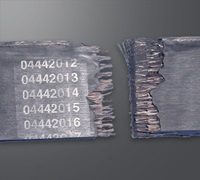When a timing belt or a Micro-V
® belt breaks, mechanics tend to blame the tensile cords, assuming that the point where they are ‘knotted or welded together’ is the belt’s Achilles heel. Yet tensile cords are never attached together in any way whatsoever. In this article, we clear up this common misunderstanding by explaining how automotive belts are made.
The function of tensile cords
Every automotive belt is reinforced with tensile cords, made from polyester (for most regular Micro-V® belts), nylon (for elastic Micro-V® belts) or glass fibre (in the case of timing belts, which is why you should never crimp them). These cords form the backbone of the belt: they do not stretch – or, in the case of elastic belts, stretch just enough to ensure proper functioning. Without them, your Micro-V® belt or timing belt would be a mere rubber band.

This belt has clearly been crimped, leading to a straight cord rupture line.
How automotive belts are made
Automotive belts are made on a metal mold, the diameter of which determines the length of the belt (the bigger the mold, the longer the belt). While the mold is rotating, the tensile cords are applied, starting on the left and
spiralling all the way to the right edge of the metal cast. More specifically, two types of cords are simultaneously twisted around the mold: an S-twisted cord and a Z-twisted cord end up side by side on the mold. The rubber is then applied to the mold, resulting in a rubber tube with tensile cords.
This rubber tube is
vulcanised into a single unit and then cut into the automotive belts we all know. The tensile cords are also cut in the process: after all, they lie at an angle, the exact angle of which depends on the diameter of the mold, while the tube is cut straight into separate belts. Yet because the tensile cords are vulcanised together with the rubber, it doesn’t matter that they are cut at the sides of the belts. They form a solid whole anyway – you could compare it to reinforced concrete, made from steel reinforcing bars and concrete.
A common misunderstanding
As you know by now,
tensile cords are never ‘knotted or welded together’. So, when a belt breaks, this can never be due to a ‘connecting point’ breaking under the pressure – a common misunderstanding among mechanics.